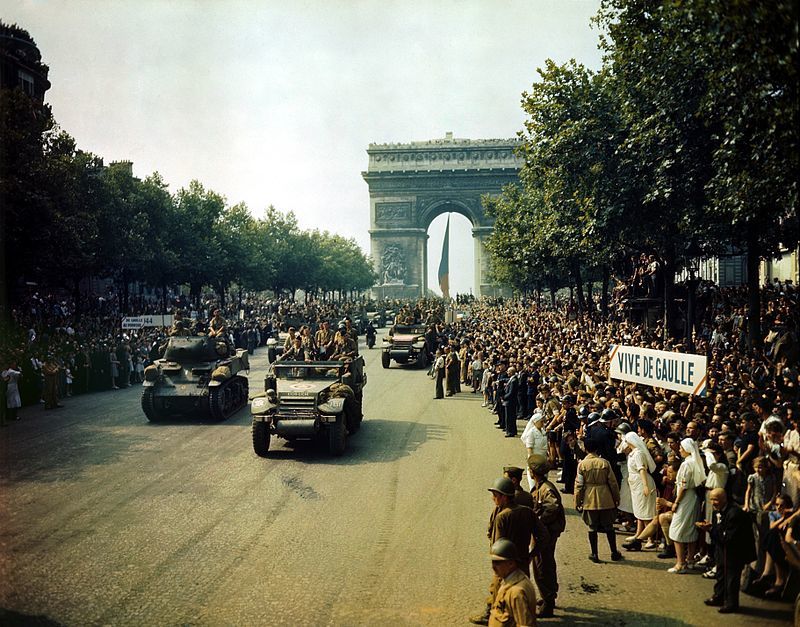The Liberation of Paris, also known as the Battle for Paris and Belgium, took place between August 19 to the 25, 1944. Paris had been under German occupation since June 14, 1940, when the German army made their way through France. The French army was easily defeated, and soon France signed an armistice with Germany. The French leaders left in charge abandoned Paris for the city of Vichy in central France, where they established a government in the non-occupied southern region of France, led by Philippe Pétain. The Vichy government, in turn, still worked with the Germans and mostly acted as a puppet state for them. Paris, in the meantime, came under the control of the German military. Not all French were content to accept the German occupation, however, and thus created resistance groups such as the Free French . Led by Charles de Gaulle, a French army General, the Free French sought to fight back against German and Vichy rule. In order to rid France of the Germans, de Gaulle and the Free French became a part of the Allies and fought alongside them. As the Allies began making their way through France, they soon set their eyes to Paris, to finally give the capital back to those fighting with them.
In late August of 1943, the French 2nd Armored Division was created in London to tackle the specifics of leading the liberation of Paris by the Allies. This Division landed at Normandy in early August of 1944, linking up with American General George Patton’s 3rd U.S. Army. By August 18, the Allies were not far from Paris, inspiring workers in the occupied city to go on strike and motivating resistance fighters to begin taking on German soldiers. Despite this momentum, Supreme Allied Commander Dwight Eisenhower was being advised by military planners to skip over Paris for the moment, in order to save resources. Then, on August 21, Eisenhower met with de Gaulle, who urged the commander to change his mind, noting that taking Paris would be simple and quick. General de Gaulle also warned that if the Allies waited, the communist faction of the resistance might be the ones to liberate Paris, thereby threatening the chances of re-establishing democracy in France. Finally, de Gaulle made clear that if Eisenhower did not send his men into Paris, de Gaulle would send the French 2nd Armored Division in himself. With these arguments in mind, Eisenhower agreed to move forward with the liberation the next day rather than delay it any longer.
On August 23 the Allies advanced on Paris from the north and the south, as the Germans were still trying to fortify the city while handling resistance fighters already on the inside. Adolf Hitler ordered German General Dietrich von Choltitz to defend Paris to the death, and if the city were to fall, the Germans must destroy all of the city’s landmarks and burn the remainder of Paris. As the Allies moved in on the city, they took on heavy German artillery fire and suffered significant casualties, but they managed to cross the Seine on August 24. That same day, despite their exhaustion, the men of the French 2nd Armored Division pushed forward and reached the Hôtel de Ville in the heart of Paris. Throughout the following night, German soldiers quickly began to flee or surrender to the Allies, while those who remained were defeated quickly. By the morning of August 25, both the eastern and western sections of the city had been captured, and Paris was finally liberated. Although von Choltitz had laid the bombs to destroy Paris’ famous landmarks, he never gave to order to detonate, as he did not want to be remembered as the man who destroyed Europe’s most cherished city.
In the afternoon of August 25, von Choltitz was arrested by French troops, and soon after signed a document which handed the city over to de Gaulle and his provincial government. The next day there was a victory parade down the Champs-Élysées that was interrupted by a few remaining German snipers who shot at the crowd. A second parade was held on August 29, as U.S. soldiers marched through the Arc de Triomphe and then down the Champs-Élysées once more. Charles de Gaulle would go on to lead two provisional governments in France until his resignation in 1946 over disagreements regarding the French constitution. He took office once more from 1958 to 1969 as the President under France’s Fifth Republic.
Suggested Reading:
HistoryNet: Liberation of Paris
Jean Edward Smith, The Liberation of Paris: How Eisenhower, de Gaulle, and von Choltitz Saved the City of Light (Simon and Schuster, 2019)
Julian Jackson, De Gaulle (Harvard University Press, 2018).








